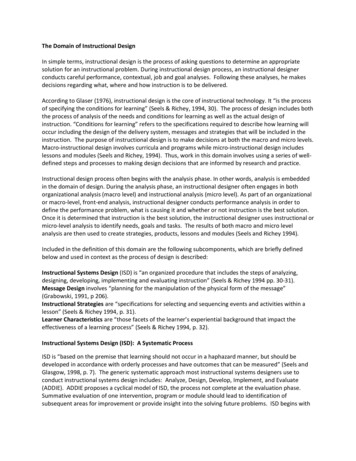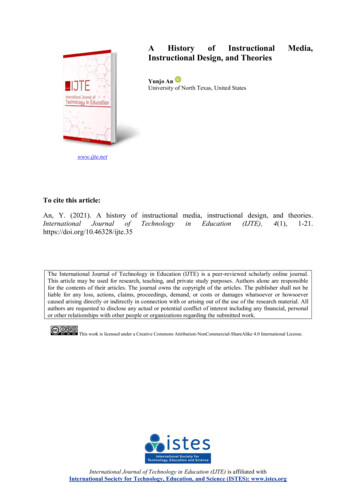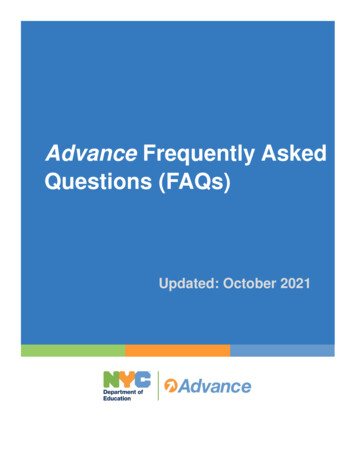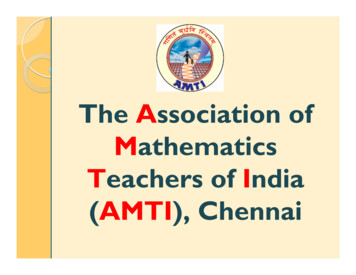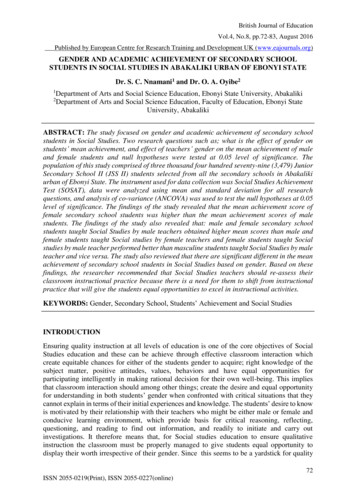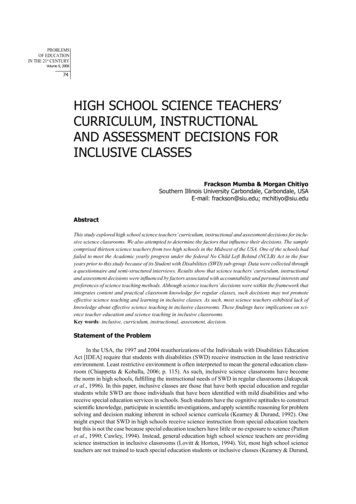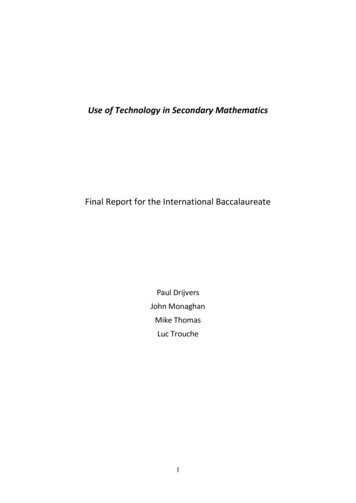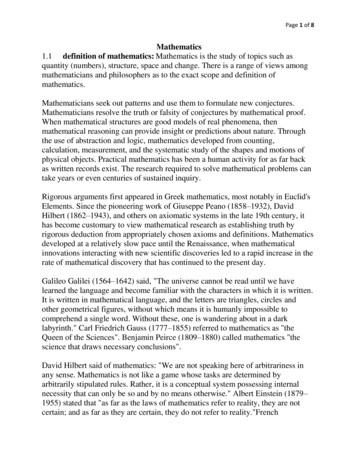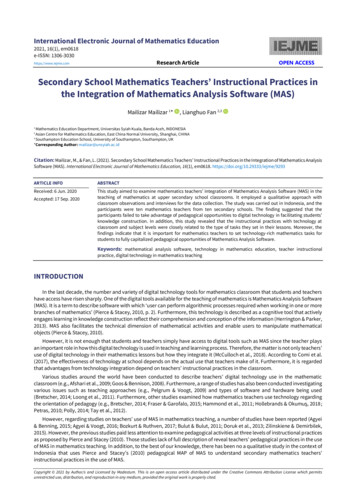
Transcription
International Electronic Journal of Mathematics Education2021, 16(1), em0618e-ISSN: 1306-3030Research Articlehttps://www.iejme.comOPEN ACCESSSecondary School Mathematics Teachers’ Instructional Practices inthe Integration of Mathematics Analysis Software (MAS)Mailizar Mailizar 1*, Lianghuo Fan 2,3Mathematics Education Department, Universitas Syiah Kuala, Banda Aceh, INDONESIAAsian Centre for Mathematics Education, East China Normal University, Shanghai, CHINA3Southampton Education School, University of Southampton, Southampton, UK*Corresponding Author: mailizar@unsyiah.ac.id12Citation: Mailizar, M., & Fan, L. (2021). Secondary School Mathematics Teachers’ Instructional Practices in the Integration of Mathematics AnalysisSoftware (MAS). International Electronic Journal of Mathematics Education, 16(1), em0618. https://doi.org/10.29333/iejme/9293ARTICLE INFOABSTRACTReceived: 6 Jun. 2020This study aimed to examine mathematics teachers’ integration of Mathematics Analysis Software (MAS) in theteaching of mathematics at upper secondary school classrooms. It employed a qualitative approach withclassroom observations and interviews for the data collection. The study was carried out in Indonesia, and theparticipants were ten mathematics teachers from ten secondary schools. The finding suggested that theparticipants failed to take advantage of pedagogical opportunities to digital technology in facilitating students’knowledge construction. In addition, this study revealed that the instructional practices with technology atclassroom and subject levels were closely related to the type of tasks they set in their lessons. Moreover, thefindings indicate that it is important for mathematics teachers to set technology-rich mathematics tasks forstudents to fully capitalized pedagogical opportunities of Mathematics Analysis Software.Accepted: 17 Sep. 2020Keywords: mathematical analysis software, technology in mathematics education, teacher instructionalpractice, digital technology in mathematics teachingINTRODUCTIONIn the last decade, the number and variety of digital technology tools for mathematics classroom that students and teachershave access have risen sharply. One of the digital tools available for the teaching of mathematics is Mathematics Analysis Software(MAS). It is a term to describe software with which ‘user can perform algorithmic processes required when working in one or morebranches of mathematics’ (Pierce & Stacey, 2010, p. 2). Furthermore, this technology is described as a cognitive tool that activelyengages learning in knowledge construction reflect their comprehension and conception of the information (Herrington & Parker,2013). MAS also facilitates the technical dimension of mathematical activities and enable users to manipulate mathematicalobjects (Pierce & Stacey, 2010).However, it is not enough that students and teachers simply have access to digital tools such as MAS since the teacher playsan important role in how this digital technology is used in teaching and learning process. Therefore, the matter is not only teachers’use of digital technology in their mathematics lessons but how they integrate it (McCulloch et al., 2018). According to Comi et al.(2017), the effectiveness of technology at school depends on the actual use that teachers make of it. Furthermore, it is regardedthat advantages from technology integration depend on teachers’ instructional practices in the classroom.Various studies around the world have been conducted to describe teachers’ digital technology use in the mathematicclassroom (e.g., Afshari et al., 2009; Goos & Bennison, 2008). Furthermore, a range of studies has also been conducted investigatingvarious issues such as teaching approaches (e.g., Pelgrum & Voogt, 2009) and types of software and hardware being used(Bretscher, 2014; Loong et al., 2011). Furthermore, other studies examined how mathematics teachers use technology regardingthe orientation of pedagogy (e.g., Bretscher, 2014; Fraser & Garofalo, 2015; Hammond et al., 2011; Hollebrands & Okumuş, 2018;Petras, 2010; Polly, 2014; Tay et al., 2012).However, regarding studies on teachers’ use of MAS in mathematics teaching, a number of studies have been reported (Agyei& Benning, 2015; Agyei & Voogt, 2016; Bozkurt & Ruthven, 2017; Bulut & Bulut, 2011; Doruk et al., 2013; Zilinskiene & Demirbilek,2015). However, the previous studies paid less attention to examine pedagogical activities at three levels of instructional practicesas proposed by Pierce and Stacey (2010). Those studies lack of full description of reveal teachers’ pedagogical practices in the useof MAS in mathematics teaching. In addition, to the best of our knowledge, there has been no a qualitative study in the context ofIndonesia that uses Pierce and Stacey’s (2010) pedagogical MAP of MAS to understand secondary mathematics teachers’instructional practices in the use of MAS.Copyright 2021 by Author/s and Licensed by Modestum. This is an open access article distributed under the Creative Commons Attribution License which permitsunrestricted use, distribution, and reproduction in any medium, provided the original work is properly cited.
2 / 11Mailizar & Fan / INT ELECT J MATH ED, 16(1), em0618We investigated the use of MAS as it is has been widely used by mathematician as well as mathematics teachers for teachingand learning of mathematics and has great potential to change teaching and learning of mathematics. Furthermore, for teachingand learning of mathematic setting, MAS may be available as computer software such as spreadsheets, dynamic geometrysoftware and dynamic mathematics software. In addition, this tool may also available as hand held devices such as scientificcalculator, graphic calculator, and computer algebra system.Due to wide availability and great potential of MAS, we believe that the findings of this study fill the gaps and advances ourunderstanding of secondary school teachers’ instructional practices when they integrate the digital tool in their mathematicsteaching. Therefore, the aim of this study was to investigate secondary school mathematics teachers’ use of Mathematical Analysissoftware in teaching mathematics through the lens of the pedagogical map of MAS (Pierce & Stacey, 2010) as well as to identifylinks between task set by the teachers with their instructional practices at subject and classroom levels. Therefore, this studyaddressed two research questions:1. To what extent do secondary school mathematics teachers use Mathematics Analysis Software in mathematics teaching?2. To what extent is the type of tasks set by the teachers related to their instructional practices in using of MathematicsAnalysis Software at subject and classroom levels?LITERATURE REVIEW AND CONCEPTUAL FRAMEWORKPrevious studies have used various frameworks to investigate the ways of digital technologies is used in teachings, such asstudent-centred and teacher-centred framework (Bretscher, 2014; Polly, 2014); the Learning with and Learning from framework(e.g., Tay et al., 2012); routine, extended and innovative user (e.g., Hammond et al., 2011). In term of the investigation of digitaltechnology in mathematics teaching, with emphasis on mathematics analysis software, Pierce and Stacey (2010) proposedframework of the pedagogical map, explaining pedagogical opportunities of Mathematics Analysis Software (MAS).As mentioned earlier, MAS is an umbrella term used to describe software with which users can conduct algorithmic processeswhen doing one or more topics of mathematics (Pierce & Stacey, 2010). With this tool, users can carry out calculations of arithmeticand statistics data display, and construction of geometric figures. Many software is available that user can conduct algorithmicprocess when users working in mathematics. MAS is available as computer software such as Excel, GeoGebra, GeometersSketchpad, and autograph as well as available as hand held calculators such as scientific calculators, graphic calculators andcomputer algebra system.The main feature of Mathematical Analysis Software is that users can use the software to do mathematical algorithms withtheir own input. It is adaptable software that users specify what it will do. Therefore, not all digital tools for mathematics teachingis MAS. It excludes software for presentation (e.g. PowerPoint) or, courseware or software for communication and drill, andpractice (Pierce & Stacey, 2010).Mathematics Analysis Software (MAS) As A Cognitive ToolAccording to Jonassen (1996b) a cognitive tool is referred to learning with technology instead of learning through technology.Kim and Reeves (2007) define a cognitive tool as a technology that users can interact and think with in process of knowledgeconstruction. Furthermore, a cognitive tool is a computer software that is intended to facilitate and engage process of cognitiveand it is a set of tool that needed by learners to facilitate cognitive apprenticeships (Jonassen, 1996b). A cognitive tool can helplearner with critical thinking and complex learning activities and it support learner to control the construction of their knowledge(Jonassen, 1996a). Shim and Li (2006) argue that a cognitive tool can benefit students providing them the following functions: (1)supporting cognitive processes; (2) haring the cognitive load; (3) allowing students to get involved in cognitive activities; and (4)allowing student to engage in problem solving activities through generating and testing hypothesesMAS is regarded as a cognitive tool that facilitates the technical dimension of mathematical activities (Zbiek et al., 2007).Cognitive tools are technologies that strengthen human being cognitive powers during thinking, problem-solving, and learning(Jonassen & Reeves, 1996, p. 639). According to Jensen (2011), the human cognitive system can be enhanced through theintegration of cognitive tool. Therefore, when cognitive tools are integrated into teaching, the approach should be different fromtraditional approaches (Wang et al., 2014). By using the cognitive tool, learners should engage in various critical, creative, andcomplex thinking opportunities (Hsu et al., 2013).Furthermore, MAS, as a digital tool, can be beneficial as learnier can organize information into a visual and auditory channel(Hillmayr et al., 2020). Furthermore, digital tools allow learners to engage actively with the content of learning in order tounderstand new information (Mayer, 2014). Interactive learning environments of a digital tool make it possible for learners toactively influence their own learning process (Hillmayr et al., 2020). Therefore, learners can manipulate presented information andinteract with learning environments that enable them to act as a sense-makers in constructing their own knowledge (Hillmayr etal., 2020). In addition, an interactive digital tool should support students deep learning through cognitive activities (Mayer, 2014).Pedagogical Map of Mathematical Analysis SoftwarePierce and Stacey (2010) proposed the pedagogical map of MAS (Figure 1) that is structured at three levels, namely the tasksteacher set for their students; teachers’ classroom interaction; and the subject being taught. According to Pierce and Stacey (2010),at the task level, MAS offers five pedagogical opportunities that are ‘learn pen and paper skills’, ‘use real data’, ‘explore regularityand variation’, ‘stimulate real situations’, and ‘link representations’.
Mailizar & Fan / INT ELECT J MATH ED, 16(1), em06183 / 11Figure 1. The pedagogical map of MAS (Pierce & Stacey, 2010)Table 1. Description of functional and pedagogical opportunitiesPedagogical opportunitiesDescription (Sample of Teachers’ Activities)Learn pen-and-paper skills (LPP)The teacher assigns students to use instant ‘answers’ as feedback in learning processesUse real data (RD)The teacher assigns students to working on real world problems involving calculationsExplore regularity and variation The teacher assigns students to search for patterns, observe effect of parameters, and use forms(RV)of general formula.Task LevelThe teacher assigns students to use dynamic diagrams, drag and collect data for analysis, andStimulate real situations (RS)generate statistical data setsThe teacher assigns students to use digital tool to move between numeric, graphic, and symbolicLink Representation (LR)representations.Change classroom social dynamicThe teacher facilitates rather than dictates, encourages group, and encourages students to(CCSD)initiate discussion and share their learningClassroomLevelChange classroom didacticThe teacher allows MAS to become a new authority, changes what is expected from students andcontract (CCDC)teachers, and permits explosion of available methodsExploit contrast of ideal andThe teacher intentionally uses unexpected error messages, expressions, graphical displays asmachine mathematics (EIMM)catalysts for discussionSubjectRebalance emphasis on skills,The teacher adjusts goals of teaching, spends less time on routine skills, more time onLevelconcepts, applications (RSCA)understanding of concepts and applications, and increases emphasis on mathematical thinking.Build metacognition and overview The teacher gives an overview as introduction, links concepts through manipulation of symbolic(BMO)expressions, and uses of multiple representations.Furthermore, the classroom level has two pedagogical opportunities, namely change of classroom social dynamic and changeof classroom didactic contract. In the classroom, MAS introduces as a new authority other than the teacher (Pierce & Stacey, 2010).As results, teachers and students my change their expectations. Furthermore, the use of MAS may encourage students to takecontrol over their learning which results a change of didactic contract (Pierce & Stacey, 2010). According to Brousseau (1997),didactic contract is 'a system of rules, mostly implicit, associating the students and the teacher, for a given piece of knowledge'(p. 15). Teacher crate situation in which can provide to student aspects of mathematics such as the use of interest of mathematics.With the use of MAS, this situation might change as students also can provide such aspects.At the subject level, MAS provides opportunities for rebalancing emphasis on skills, concepts, and applications, and buildingmetacognition and overview, as well as exploiting the contrast between ideal and machine mathematics. Based on thepedagogical map of MAS, we present a framework of this study in terms of teachers’ activities at each level of their instructionalpractices in Table 1.
4 / 11Mailizar & Fan / INT ELECT J MATH ED, 16(1), em0618Table 2. Demographic Information of nRahmanErliAryGenderFFFMMFMMFMTeaching Experience1 Year2 Years13 Years20 Years8 Years17 Years10 Years11 Years4 Years14 YearsLevel of EducationUndergraduate degreeUndergraduate degreeUndergraduate degreeUndergraduate degreeUndergraduate degreePost-Graduate degreePost-Graduate degreePost-Graduate degreePost-Graduate degreePost-Graduate degreeMETHODSResearch DesignIn this study, we employed a case study approach to examine mathematics teacher instructional practices when they use MASin mathematics teaching (Merriam & Tisdell, 2015). According to (Merriam & Tisdell, 2015), a qualitative case study is a holisticdescription of a bounded phenomenon such as a person or a process. The data of the present study were collected from a boundedphenomenon, which is mathematics teachers who have experiences in using of Mathematics Analysis Software in theirclassrooms. The cases were selected to understand the phenomena of teachers’ MAS integration according to the three levels ofpedagogical opportunities.ParticipantsTo recruit the participants, we distributed a questionnaire asking the participants whether they have used MathematicalAnalysis Software in their classrooms and were willing to participate in this study. Accordingly, fourty teachers were willing to takepart. Furthermore, we referred to Guest et al. (2006) in determining the number of participants. They suggest that 12 participantsare adequate sample size for qualitative research. Therefore, we selected 12 out of the 40 participants. However, two participantsdid not satisfy the criteria of this study because when we observed in their teaching, they used PowerPoint instead of MAS.Therefore, only ten participants were analysed, as shown in Table 2. Anonymity of participants was ensured; therefore, their realnames did not appear.Research InstrumentAs previously mentioned, Pierce and Stacey’s (2010) pedagogical map were adapted as a framework to investigate teachers’instructional practice in the use of Mathematic Analysis Software. Therefore, the classroom observations and semi-structuredinterview focused on teachers’ instructional practices at the subject level, classroom level, and task level. We used the observationsheet for documenting important data in terms of the three aspects of the instructional practices. Furthermore, we used aninterview protocol related to the three levels of teacher instructional practices.Reliability and ValidityAccording to (Creswell, 2007), triangulation, which different sources and methods are used, is one of the strategies to validatea qualitative study. In the present study, we carried out triangulation involving data from classroom observations and semistructured interviews to strengthen the trustworthiness of the study. Furthermore, in a qualitative study, reliability refers to thestability of responses to multiple coders of a data set (Creswell, 2007). Therefore, in the present study, we developed a codebookof code to enhance reliability.A codebook is defined as set of codes, definitions, and examples that is utilized as a guide in analysis of interview data. It isnecessary in analysing of interview data since it provide operationalization of the coded (Fonteyn et al., 2008). In this study, weused theory driven coded that involving three steps as proposed by (Boyatzis, 1998). The steps are included: (1) generating thecode; (2) reviewing and revising the conde; and (3) determining the reliability of coders and the codes.Procedure for Data CollectionAs discussed previously, data were collected through classroom observations and semi-structured interview. Twelveparticipants participate in the classroom observations and interviews. We observed one lesson for each participant which took60-90 minutes. The participants were free to decide on what topic they would like to teacher according to their teaching schedules.To ensure we captured all the classroom activities, we video all the observed classes. We observed various lesson as shown inTable 3.
Mailizar & Fan / INT ELECT J MATH ED, 16(1), em06185 / 11Table 3. Topics of Mathematics being manErliAryTopics being -dimensional geometryTranslationGraphs of trigonometric functionsDifferential calculusInverse functionsReflectionClassroom observations were followed up with semi structured interviews. We allowed participants to decided time and placesfor the interviews. As a result, all participants would like to be interviewed right after the observations. We interviewed nineparticipants in their offices while one participant was interviewed in a school park. It took about 30-40 minutes of the interviewand we audiotaped all the participants.Data AnalysisIn a qualitative study, the researcher can employ both deductive and inductive approaches in analysing the data (Azungah,2018; Burnard et al., 2008). The deductive approach uses an organising framework consisting of themes for coding process, whilethe inductive approach involves data that drive analysis entirely (Bradley et al., 2007). In this study, we employed a deductivequalitative analysis approach to analyse classroom observation and interview data by using an existing framework, that is thePedagogical Map of MAS (Pierce & Stacey, 2010). Furthermore, we carried out data triangulation resulting from classroomobservations and interviews.RESULTSIn this section, we describe teachers’ instructional practices in the use of MAS regarding the conceptual framework. It isimportant to highlight that we present teachers’ instructional practices according to data of classroom observations and semistructured interviews. Therefore, only activities that were appeared in the observations and revealed in the interviews wereregarded as teachers’ instructional practices. Furthermore, we identified patterns of teachers’ instructional practice at classroomand subject levels according to the type of tasks they set for the students.Teachers’ Instructional PracticesTask levelThe framework of MAS offers five types of tasks that teachers can set for students when they use MAS in mathematics teaching.The tasks namely ‘learn pen-and-paper skills’, ‘explore regularity and variation’, ‘link representation’, ‘simulate real situations’and ‘use real data’. This study showed that the participants had provided different type of tasks to their students, and some of theteacher assigned two more type of tasks in one lesson.Five participants (Ina, Mirna, Aan, Ary and Alfi) provided two types of tasks in one lesson. For example, Aan assigned hisstudents to use a slider on Autograph to investigate the parameter of ‘A’ of trigonometric functions Y A sin X and Y A Cos X.Furthermore, students were assigned to observe changes in the graphs when the parameter was changed. Aan also assignedstudents to observe the parameter of “A” and “B” for the function of Y Sin AX B and Y Cos AX B. At the end of the lesson, Aanassigned students to draw a conclusion about the parameters. It revealed that Aan provided tasks that encourage his students touse MAS in exploring regularity and variation, and then making conjectures before proceeding to formal proof.Five participants (Erli, Tia, Rahman, Lila and Yudin) offered on one type of task. Four (Erli, Tia, Rahman and Lila) of them setthe ‘learn pen-and-paper skill’ task. For example, Tia asked students to check their solutions of translation problems by usingGeoGebra. Another teacher who provided one type of tasks was Yudin. His students were assigned to use GeoGebra to plot andmove circles. Furthermore, the students observed the objects and their propertiesDrawing on classroom observation and the interview data, we conclude that ‘learn pen-and-paper skills’ task, ‘exploreregularity and variation’, and ‘link representation’ were three most frequently set task by the participants when they integrateMAS in their lessons. However, the findings show that no participant who set tasks of using real data and stimulate real situation.Table 4 is the summary of the participants’ use of MAS at the task level.
6 / 11Mailizar & Fan / INT ELECT J MATH ED, 16(1), em0618Table 4. Summary of participants’ use of MAS at the task ErliAryParticipants’ Instructional PracticesRV and LRRV and LRLPPLRLPP and RVLPPRV and LRLPPLPPRV and LRTable 5. Summary of participants’ use of MAS at the classroom ErliAryParticipants’ Instructional PracticesCCSD and CCDCCCSDCCSDCCSD and CCDCCCSDCCSDClassroom levelAt the classroom level, we focused on the change of cognitive and social aspects, namely “change classroom didactic contract”and “change classroom social dynamics. Regarding “change classroom didactic contract”, It showed that three participants (Ina,Aan and Ary) indicated they use MAS in ways that this digital technology was as a new ‘authority’ other than the teacher. Theirstudents were assigned to use MAS to carry put their mathematical explorations and to share their findings to the teacher and therest of the class. For example, Aan used the discovery-learning method with various activities such as discussions and completingthe tasks. He assigned the students four tasks and worked in groups with the help of MAS. In Aan’s lesson, the didactic contractwas changed where students provided their own explanations and discovered their own generalisations rather than relying on theteacher. Furthermore, students shared their findings to other students and explained their reasons. Furthermore, the socialdynamic was also changed since students worked collaboratively and discussed in groups.In terms of classroom social dynamic, the results showed that six teachers (Ina, Mirna, Aan, Ary, Rahman and Lila) had changedtheir classroom dynamics when they integrated MAS in their lessons. For example, Lila used dynamic mathematics software toteach the concept of reflection. Students were assigned to work in a group of four students to four problems, one of them was tofind the reflection of x 2 y 2-4x 2y-4 0 in y x. Furthermore, each group was assigned to present solutions to the problems toother groups, while the other groups checked the presented solutions with GeoGebra. The classroom dynamics were changedwhen students used MAS and worked in groups. In the interview, one of the participants, Ina revealed that:“The interaction between students and me and interaction between students and students were improved, and I liked itbecause two-way communication took place in the classroom; there were questions and answers, discussion among andbetween students. In the observed class, I was not satisfied because there was one group that had too many students.Normally, I assigned students to work in a group of two students in order to minimise the number of students who areinactive. Thus, students discussed in pairs.’It is shown that at the classroom level, Ina took advantage of the pedagogical opportunities of MAS to change her classroomsocial dynamics. Table 5 summarises findings of participants’ use of MAS at the classroom level. It shows that, at the classroomlevel, more than half of the participant has successfully changed their classroom social dynamic when MAS was integrated intotheir lessons. Nevertheless, the majority of classroom didactic contract remained the same since only two participants whoindicated the change of this aspect when they integrated the digital tools.Subject levelRegarding subject-level opportunities, three opportunities offered by MAS are building metacognition and overview;rebalancing emphasis on skills, concepts, and applications; and exploiting the contrast between ideal and machine mathematics.Therefore, we present the results based on those themes.It was revealed that there were three participants (Ina, Mirna and Ary) who built metacognition and overview of mathematicstopics in their mathematics teaching. They started their lessons with overviews of the real-world context instead of with details ofmathematical concepts. Ary, for instance, in the observed class, started his lesson by inserting a picture of a butterfly into DynamicGeometry Software and showing his students the ‘reflection’ of the butterfly.
Mailizar & Fan / INT ELECT J MATH ED, 16(1), em06187 / 11Table 6. Summary of participants use MAS at the subject ErliAryParticipants’ Instructional PracticesRSCA and BMORSCA and BMORSCARSCA, and BMOTable 7. Pattern of participants’ instructional iaErliYudinTask LevelRV and LRRV and LRRV and LRRV and LRLPP and RVLPPLPPLPPLPPLRClassroom LevelCCSD and CCDCCCSDCCSD and CCDCCCSDCCSDCCSD-Subject LevelRSCA and BMORSCA and BMORSCARSCA, and BMO-Those three participants indicated that the use of MAS had changed their approach to mathematics topics. One of theparticipants revealed that:“By using technology, it changed my approach to teaching. For example, in the classroom, I first gave students problemsto be solved by using the tool, and then, through solving the problems, students discovered the concepts of a topic inmathematics.”Mirna started the lesson by solving problems instead of solving problems at and the end of the lesson as presented in thetextbook. After working on the problems, the teacher and students then revisited formal mathematical concepts through theteacher’s exposition. However, most of the participants did not change their approach to mathematics topics when they used MASin the classroom. Also, they did not take advantage of this tool to encourage students to build metacognition and an overview ofmathematics topics.Regarding exploit contrast between ideal and machine mathematics, when teachers use MAS they may deliberately takeadvantage of the constraints the technology to provoke students’ mathematical thinking. However, in the observations and theinterviews, it was revealed that there was no participant who exploited the contrast between ideal and machine mathematics.As described in the pedagogical map of MAS, rebalance emphasis on skill, concepts, and applications is another pedagogicalopportunity offered by the tool. The result of classroom observation and interview revealed that four participants (Ina, Mirna, Aanand Ary) spent time in their teaching to present applications of mathematics concepts. Ina, for instance, used 20 minutes of hertime for presenting applications of translation in real-life. In the interview, one of the participants said that:“Applications of mathematics concepts should be emphasised when students use ICT in the classroom, it is not a trial anderror activity but without understanding what students are doing. For example, when I taught the topic of reflection,students used GeoGebra to reflect a picture of a cat in Y-axis, thus, students found that the result of the reflections was notchanged, if they reflected a picture of a cat, the result was still a cat; therefore, students learned concepts of reflection thatreflection does not change the shape of an object.”Finally, Table 6 highlights the participants use of MA at subject level.In summary, the findi
This study aimed to examine mathematics teachers integration of Mathematics Analysis Software (MAS) in the teaching of mathematics at upper secondary school classrooms. It employed a qualitative approach with classroom observations and interviews for the data collection. The study was carried out in Indonesia, and the
